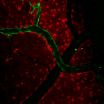(Press-News.org) VIDEO:
Real-time movie of changes in total hemoglobin in the brain during stimulation. The initial blush of the brain is followed quickly by dilation (red) of arteries on the brain's surface....
Click here for more information.
New York, NY—June 12, 2014—In a new study published online in the Journal of the American Heart Association June 12, 2014, researchers at Columbia Engineering report that they have identified a new component of the biological mechanism that controls blood flow in the brain. Led by Elizabeth M. C. Hillman, associate professor of biomedical engineering, the team has demonstrated, for the first time, that the vascular endothelium plays a critical role in the regulation of blood flow in response to stimulation in the living brain.
"We think we've found a missing link in our understanding of how the brain dynamically tunes its blood flow to stay in sync with the activity of neurons," says Hillman, who has a joint appointment in Radiology. Hillman has spent more than 10 years using advanced imaging tools to study how blood flow is controlled in the brain. "Earlier studies identified small pieces of the puzzle, but we didn't believe they formed a cohesive 'big picture' that unified everybody's observations. Our new finding seems to really connect the dots."
Understanding how and why the brain regulates its blood flow could provide important clues to understanding early brain development, disease, and aging. The brain increases local blood flow when neurons fire, and this increase is what is detected by a functional magnetic resonance imaging (fMRI) scan. Hillman found that the vascular endothelium, the inner layer of blood vessels, plays a critical role in propagating and shaping the blood flow response to local neuronal activity. While the vascular endothelium is known to do this in other areas of the body, until now the brain was thought to use a different, more specialized mechanism and researchers in the field were focused on the cells surrounding the vessels in the brain.
"Once we realized the importance of endothelial signaling in the regulation of blood flow in the brain," Hillman adds, "we wondered whether overlooking the vascular endothelium might have led researchers to misinterpret their results."
"As we identified this pathway, so many things fell into place," she continues, "We really hope that our work will encourage others to take a closer look at the vascular endothelium in the brain. So far, we think that our findings have far-reaching and really exciting implications for neuroscience, neurology, cardiovascular medicine, radiology, and our overall understanding of how the brain works."
This research was carried out in Hillman's Laboratory for Functional Optical Imaging, led by PhD student and lead author on the study, Brenda Chen. Other lab members who assisted with the study included PhD and MD/PhD students from Columbia Engineering, Neurobiology and Behavior, and Columbia University Medical Center. The group combined their engineering skills with their expertise in neuroscience, biology, and medicine to understand this new aspect of brain physiology.
To tease apart the role of endothelial signaling in the living brain, they had to develop new ways to both image the brain at very high speeds, and also to selectively alter the ability of endothelial cells to propagate signals within intact vessels. The team achieved this through a range of techniques that use light and optics, including imaging using a high-speed camera with synchronized, strobed LED illumination to capture changes in the color, and thus the oxygenation level of flowing blood. Focused laser light was used in combination with a fluorescent dye within the bloodstream to cause oxidative damage to the inner endothelial layer of blood brain arterioles, while leaving the rest of the vessel intact and responsive. The team showed that, after damaging a small section of a vessel using their laser, the vessel no longer dilated beyond the damaged point. When the endothelium of a larger number of vessels was targeted in the same way, the overall blood flow response of the brain to stimulation was significantly decreased.
"Our finding unifies what is known about blood flow regulation in the rest of the body with how it is regulated in the brain," Hillman explains. "This has wider reaching implications since there are many disease states known to affect blood flow regulation in the rest of the body that, until now, were not expected to directly affect brain health." For instance, involvement of the endothelium might explain neural deficits in diabetics; a clue that could lead to new diagnostics tests and treatments for neurological conditions associated with broader cardiovascular problems.
"Improving our fundamental understanding of how and why the brain regulates its blood flow is key to understanding how and when this mechanism could be altered or broken," she says. "We think this could extend to studies of early brain development, aging, and diseases such as Alzheimer's and dementia."
The team's research findings may also explain the effects of some drugs on the brain, and on the fMRI response to stimulation, since the vascular endothelium is exposed to chemicals in the bloodstream. "Overall, this work could dramatically improve our ability to interpret fMRI data collected in humans, perhaps making it a better tool for doctors to understand brain disease," she adds.
Hillman plans next to address the broad range of implications her latest finding may have. She wants to explore the effects of drugs and disease states on the coupling of blood flow to neuronal activity in the brain, and is now starting studies to explore fMRI data from a range of different disease states to see whether she can find signs of neurovascular dysfunction. She is also working on characterizing the co-evolution of neuronal and hemodynamic activity during brain development and is beginning to develop new imaging tools that will enable non-invasive, inexpensive monitoring of brain hemodynamics in infants and children who cannot be imaged within an MRI scanner.
"Our latest finding gives us a new way of thinking about brain disease—that some conditions assumed to be caused by faulty neurons could actually be problems with faulty blood vessels," Hillman adds. "This gives us a new target to focus on to explore treatments for a wide range of disorders that have, until now, been thought of as impossible to treat. The brain's vasculature is a critical partner in normal brain function. We hope that we are slowly getting closer to untangling some of the mysteries of the human brain."
INFORMATION:
This research is supported by the National Institutes of Health (through the National Institute of Neurological Disorders and Stroke) as well as the National Science Foundation, the Human Frontier Science Program and the Rodriguez family.
Brain power
New insight into how the brain regulates its blood flow
2014-06-12
ELSE PRESS RELEASES FROM THIS DATE:
Time-lapse study reveals bottlenecks in stem cell expansion
2014-06-12
A time-lapse study of human embryonic stems cells has identified bottlenecks restricting the formation of colonies, a discovery that could lead to improvement in their use in regenerative medicine.
Biologists at the University of Sheffield's Centre for Stem Cell Biology led by Professor Peter Andrews and engineers in the Complex Systems and Signal Processing Group led by Professor Daniel Coca studied human pluripotent stem cells, which are a potential source of cells for regenerative medicine because they have the ability to produce any cell type in the body.
However, ...
Synchronized brain waves enable rapid learning
2014-06-12
CAMBRIDGE, MA -- The human mind can rapidly absorb and analyze new information as it flits from thought to thought. These quickly changing brain states may be encoded by synchronization of brain waves across different brain regions, according to a new study from MIT neuroscientists.
The researchers found that as monkeys learn to categorize different patterns of dots, two brain areas involved in learning — the prefrontal cortex and the striatum — synchronize their brain waves to form new communication circuits.
"We're seeing direct evidence for the interactions between ...
Scientists find trigger to decode the genome
2014-06-12
Scientists from The University of Manchester have identified an important trigger that dictates how cells change their identity and gain specialised functions.
And the research, published today in Cell Reports, has brought them a step closer to being able to decode the genome.
The scientists have found out how embryonic stem cell fate is controlled which will lead to future research into how cells can be artificially manipulated.
Lead author Andrew Sharrocks, Professor in Molecular Biology at The University of Manchester, said: "Understanding how to manipulate cells ...
12 minutes of exercise improves attention, reading comprehension in low-income adolescents
2014-06-12
HANOVER, N.H. – June 12, 2014 – A new Dartmouth study Dartmouth study shows 12 minutes of exercise can improve attention and reading comprehension in low-income adolescents, suggesting that schools serving low-income populations should work brief bouts of exercise into their daily schedules.
The study, published as part of the June volume of Frontiers in Psychology, compared low-income adolescents with their high-income peers. While both groups saw improvement in selective visual attention up to 45 minutes after exercising, the low-income group experienced a bigger jump. ...
Opioid use prior to spine surgery linked to diminished patient reported outcomes
2014-06-12
ROSEMONT, Ill.─A new study appearing in the Journal of Bone and Joint Surgery (JBJS) links the use of opioid pain relievers (prescription medications, such as Percocet) to less improvement and higher levels of dissatisfaction following spine surgery.
Between 1999 and 2010, a greater focus on pain management resulted in a four-fold increase in opioids sold to hospitals, pharmacies and doctors' offices, and a related and ongoing increase in opioid-related complications, including opioid dependence, impaired cognition and poor treatment outcomes. Previous studies have ...
NASA and NOAA satellites analyze Category 4 Hurricane Cristina
2014-06-12
VIDEO:
On June 11, NASA's TRMM satellite found rain falling at a rate of over 74.4 mm/2.9 inches per hour in a strong feeder band east of Hurricane Cristina's eye.Another area...
Click here for more information.
A fleet of satellites from NASA and NOAA are on the job monitoring the first major hurricane of the Eastern Pacific Ocean Season as Hurricane Cristina has reached Category 4 status on the Saffir-Simpson scale.
This morning, June 12, at 1200 UTC (8 a.m. EDT), NOAA's GOES-West ...
Families like practical group wellness program -- and lose weight
2014-06-12
Seattle, WA—Many children are obese these days, but what can be done about it? Research-proven treatments for obesity exist, but they rely on regular one-on-one meetings with a trained health coach. So these "behavioral" treatments are seldom available outside of research studies in specialty medical centers.
It's feasible and acceptable to give this same kind of behavioral treatment to groups of families in primary care, Paula Lozano, MD, MPH, found. She published results of the Family Wellness Program in the Permanente Journal. She is a Group Health pediatrician and ...
Standing up gets groups more fired up for team work
2014-06-12
June 12, 2014 – Chairs provide great support during long meetings, but they may also be holding us back. Standing during meetings boosts the excitement around creative group processes and reduces people's tendency to defend their turf, according to a new study that used wearable sensors.
"Organizations should design office spaces that facilitate non-sedentary work," says Andrew Knight of the Olin Business School at Washington University. Removing chairs could be a low-cost way to redesign an office space while also tackling the health effects of sitting in one place ...
Heart rate variability may predict risk of disease in premature infants
2014-06-12
Measuring variability of heart rate may identify premature infants at risk of developing necrotizing enterocolitis, a serious inflammatory condition that can lead to death, according to Penn State College of Medicine researchers.
Necrotizing enterocolitis, or NEC, may lead to destruction of the intestinal wall and vital organ failure. It affects 6 to 10 percent of premature infants within the first two weeks of life.
"NEC is currently diagnosed by a combination of laboratory and radiology tests, usually done when the disease is already significant," said Kim Doheny, director ...
Acidification and warming threaten Mediterranean Sea iconic species
2014-06-12
This is of particular importance to the Mediterranean coastal societies with 300 million inhabitants (living and visiting), unique ecosystems, love of seafood and its role as a focus for tourist worldwide.
Research professor Patrizia Ziveri, from Institute of Environmental Science and Technology at the UAB and the coordinator of the project says "We knew next to nothing about the combined effects of warming and acidification in the Mediterranean until this study, now we know that they are a serious double threat to our marine ecosystems."
"Iconic Mediterranean ecosystems ...
LAST 30 PRESS RELEASES:
Making lighter work of calculating fluid and heat flow
Normalizing blood sugar can halve heart attack risk
Lowering blood sugar cuts heart attack risk in people with prediabetes
Study links genetic variants to risk of blinding eye disease in premature infants
Non-opioid ‘pain sponge’ therapy halts cartilage degeneration and relieves chronic pain
AI can pick up cultural values by mimicking how kids learn
China’s ecological redlines offer fast track to 30 x 30 global conservation goal
Invisible indoor threats: emerging household contaminants and their growing risks to human health
Adding antibody treatment to chemo boosts outcomes for children with rare cancer
Germline pathogenic variants among women without a history of breast cancer
Tanning beds triple melanoma risk, potentially causing broad DNA damage
Unique bond identified as key to viral infection speed
Indoor tanning makes youthful skin much older on a genetic level
Mouse model sheds new light on the causes and potential solutions to human GI problems linked to muscular dystrophy
The Journal of Nuclear Medicine ahead-of-print tip sheet: December 12, 2025
Smarter tools for peering into the microscopic world
Applications open for funding to conduct research in the Kinsey Institute archives
Global measure underestimates the severity of food insecurity
Child survivors of critical illness are missing out on timely follow up care
Risk-based vs annual breast cancer screening / the WISDOM randomized clinical trial
University of Toronto launches Electric Vehicle Innovation Ontario to accelerate advanced EV technologies and build Canada’s innovation advantage
Early relapse predicts poor outcomes in aggressive blood cancer
American College of Lifestyle Medicine applauds two CMS models aligned with lifestyle medicine practice and reimbursement
Clinical trial finds cannabis use not a barrier to quitting nicotine vaping
Supplemental nutrition assistance program policies and food insecurity
Switching immune cells to “night mode” could limit damage after a heart attack, study suggests
URI-based Global RIghts Project report spotlights continued troubling trends in worldwide inhumane treatment
Neutrophils are less aggressive at night, explaining why nighttime heart attacks cause less damage than daytime events
Menopausal hormone therapy may not pose breast cancer risk for women with BRCA mutations
Mobile health tool may improve quality of life for adolescent and young adult breast cancer survivors
[Press-News.org] Brain powerNew insight into how the brain regulates its blood flow




